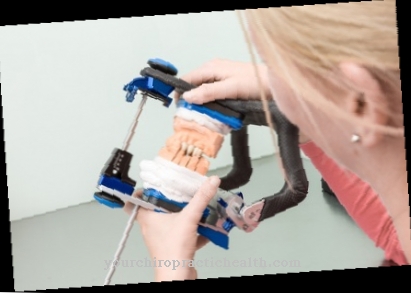A Laser coagulation is a common treatment method in ophthalmology. It is used in various diseases of the retina and can reliably prevent it from progressing.
What is laser coagulation?

Under the term Laser coagulation Doctors understand a therapeutic method from ophthalmology that is used to treat certain diseases of the retina. Different types of lasers can be used to treat the diseased or altered retina.
This procedure deliberately creates small scars on the retina that prevent blood vessels from forming or holes from spreading. Various diseases of the retina can be contained in this way. This is only damaged to such an extent that the patient does not notice any impairment, for example in vision. Before the procedure, the retina is anesthetized locally. Laser coagulation has been a method that has been known since 1949, but has been significantly further developed since then.
Function, effect & goals
A Laser coagulation always takes place in ophthalmology when there is a disease or injury to the retina that can be treated or contained with the help of laser beams.
A very common area of application is, for example, diabetes in the eye, in which what is known as macular edema occurs. This can severely swell and significantly impair the patient's vision. With the help of laser coagulation, the edema can be prevented from swelling, so that further loss of vision can usually be prevented. A vascular occlusion in the retina can also be treated in this way.
If the diseases just mentioned progress untreated, it can lead to impaired vision and even blindness, as well as the formation of defective and / or brittle blood vessels. This can lead to bleeding inside the eye. Macular degeneration, which causes small holes in the retina, often occurs in advanced age.
With the help of laser coagulation, these can be sealed so that the damage cannot progress any further. In the worst case, macular degeneration ends in complete detachment of the retina.
If the retina has already been detached, laser coagulation can no longer take place, as the treatment would no longer be successful in this case. Laser coagulation is also not possible if the eyes are cloudy, for example due to a cataract. A comprehensive examination of the patient prior to treatment is therefore urgently needed to determine his or her suitability for the procedure.
Before the procedure is carried out, the eye is numbed with local anesthetic drops. A so-called contact lens is then placed on the eye itself.
Finally, the actual treatment with the laser beams takes place. The affected areas of the retina will immediately scar, thus preventing the disease or damage mentioned above from progressing.
You can find your medication here
➔ Medicines for visual disturbances and eye complaintsRisks & dangers
Basically one is Laser coagulation a frequently performed routine procedure that only rarely leads to complications. Of course, like any eye treatment, it carries a certain theoretical risk.
After laser coagulation, bleeding or increased intraocular pressure rarely occurs. Pain is extremely rare as a result of treatment, as is major injury or infection. Since laser coagulation always damages cells that can be seen by the laser, in individual cases this can lead to a deterioration in vision or even complete blindness. Loss of the entire eye is theoretically possible, but is one of the absolute exceptions.
Under certain circumstances, allergic reactions can occur in the context of laser coagulation. In order to rule this out as far as possible, patients should speak to the treating doctor in advance about any allergies and intolerances they may have and inform him immediately if symptoms occur. Laser coagulation that is carried out professionally and takes place when the disease / damage to the retina has not progressed too far generally has a very favorable prognosis.
A progression of the symptoms can be prevented in most cases. Sometimes there is also an improvement in vision. However, existing damage to the retina cannot be repaired using laser coagulation, but remains as before.
























.jpg)



